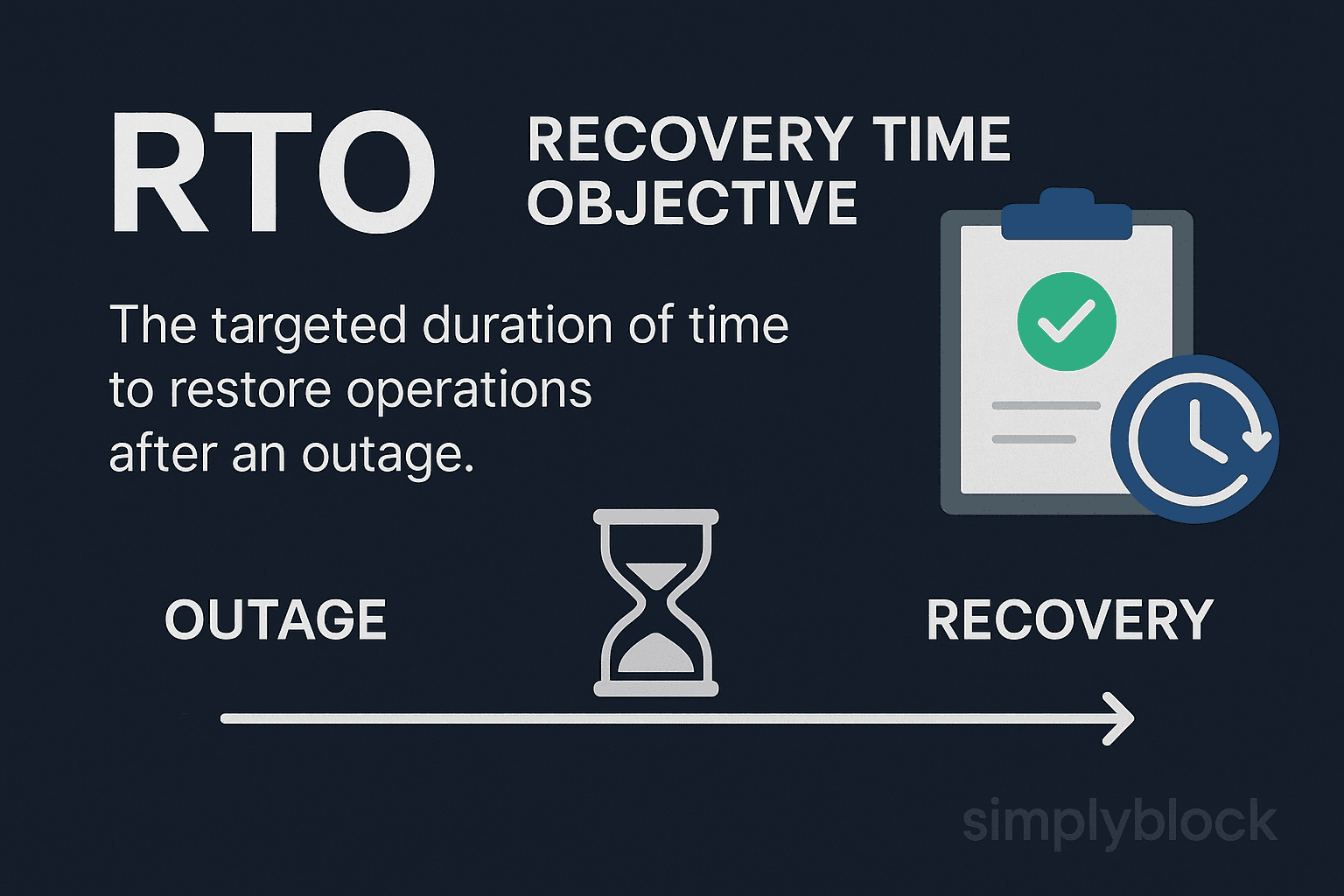RTO
Terms related to simplyblock
RTO (Recovery Time Objective) is a key metric in business continuity and disaster recovery. It defines the maximum acceptable time that a system, application, or service can be down after a failure before causing significant disruption or financial loss.
In simple terms, RTO answers the question:
“How quickly must we recover this system after an outage?”
If your RTO is 30 minutes, your infrastructure must be able to restore the service within that time frame. This differs from RPO (Recovery Point Objective), which deals with how much data you can afford to lose. Together, RTO and RPO define a system’s overall resilience strategy.
How RTO Works
RTO is determined by the business impact of downtime for specific systems. Critical applications—such as real-time payment systems or Kubernetes control planes—may require RTOs of just a few seconds. Others, like reporting dashboards or batch processing tools, can tolerate longer recovery windows.
Key technologies that reduce RTO include:
- Instant Snapshots & Clones
- Failover Volumes and Hot Standby Nodes
- Cross-Zone and Cross-Region Replication
- Automated Orchestration via SDS or Kubernetes
- Load Balancers & DNS Failover
Simplyblock supports RTO targets through instant failover, high-availability volume replication, and volume-level telemetry, ensuring services can be brought back online quickly, even in multi-tenant, hybrid cloud environments.

Benefits of Setting an RTO
- Prioritizes Recovery Efforts: Helps focus disaster response on the most time-sensitive services.
- Supports SLA and Compliance: Aligns recovery plans with customer-facing service guarantees.
- Improves Resilience Planning: Helps IT teams select the right tools, replication methods, and infrastructure.
- Reduces Risk: Prevents prolonged outages that may lead to SLA violations, customer loss, or regulatory fines.
- Enables Budget Accuracy: Guides investment in redundancy and failover systems based on risk tolerance.
RTO becomes especially important in environments like Kubernetes-native storage, where workloads are ephemeral and rapid provisioning is essential.
RTO vs RPO
RTO and RPO are complementary but distinct recovery objectives. Here’s a quick comparison:
| Aspect | RTO (Recovery Time Objective) | RPO (Recovery Point Objective) |
|---|---|---|
| Purpose | Max time to restore service | Max data loss acceptable |
| Focus | Downtime tolerance | Data loss tolerance |
| Measured In | Minutes to hours | Seconds to hours |
| Applies To | Apps, systems, services | Data, backups, replication |
| Example | “Restore in 30 mins” | “No more than 5 mins of data loss” |
| Tech Used | Failover, replication, orchestration | Snapshots, backup, erasure coding |
A high-availability storage system should meet both objectives to ensure data is preserved and accessible within the required timeframes.
Use Cases for RTO
- Transactional Databases: PostgreSQL, Oracle, and financial systems require near-zero RTO.
- E-commerce Platforms: Service recovery must be near-instant to avoid revenue loss.
- SaaS Environments: User experience degrades rapidly if downtime extends beyond a few minutes.
- Kubernetes Deployments: Containers and persistent volumes must be restored quickly to resume operations.
- Edge & Remote Locations: Remote failover and instant volume syncs minimize service interruption.
In hybrid and multi-cloud deployments, meeting RTO often means leveraging cross-region storage replication and dynamic failover mechanisms.
RTO in Simplyblock™
Simplyblock is designed to help enterprises meet strict RTO targets with:
- Fast NVMe-over-TCP replication: Reduces recovery time in distributed environments.
- Erasure-coded fault tolerance: Protects data with minimal overhead and rapid rebuild capability.
- High-performance snapshots: Support near-instant volume cloning and rollback.
- Kubernetes-native volume management: Enables automated failover in persistent volume claims.
- Multi-tenant failover orchestration: Ensures one workload’s outage doesn’t cascade into another’s.
Whether operating in the cloud, at the edge, or in containerized systems, simplyblock delivers sub-minute RTO support for critical workloads.
Related Topics
RTO in the context of broader IT resilience:
External Resources
- Recovery Time Objective – Wikipedia
- Understanding Business Continuity and Disaster Recovery – IBM
- AWS DR Planning – Whitepaper
- Azure Backup – Microsoft Learn
- NIST Cybersecurity Recovery Guidelines (SP 800-184)
Questions and Answers
RTO (Recovery Time Objective) is the maximum acceptable duration for restoring services after a failure. It defines how quickly systems must be back online to avoid serious business disruption. A low RTO is critical for databases, SaaS apps, and stateful Kubernetes workloads.
RTO focuses on how long recovery takes, while RPO focuses on how much data can be lost. Both guide storage architecture and fault-tolerant infrastructure, ensuring continuity during outages or disasters.
Fast volume failover, instant snapshots, and NVMe over TCP storage enable rapid recovery. These technologies ensure minimal downtime by reducing the time to remount and restore persistent volumes in containerized or VM-based environments.
In Kubernetes, RTO is reduced by using StatefulSets with persistent volumes and CSI-compatible storage that supports fast rescheduling and automatic recovery. Platforms like Simplyblock ensure sub-second volume recovery with Kubernetes-native NVMe storage.
Encryption at rest may slightly increase volume mount time, but has minimal impact if managed efficiently. Encrypted storage can still achieve low RTO by ensuring that security doesn’t delay recovery in production environments.
